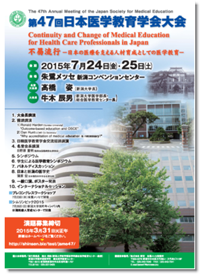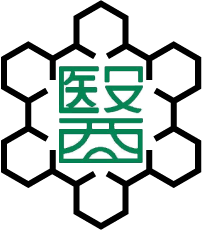Comprehensive Medical Education Center
HOME > Activities > Comprehensive Medical Education
Comprehensive Medical Education Center Place: Central Laboratories F5
1.Introduction of Staff
Faculty
- Tatsuo USHIKI, Professor, Part-time, President of Center, Medical education in general (Histology)
- Toshiya SUZUKI, Professor, Full-time, Vice-president of Center, Medical education in general (Hematology)
- Masahiro ITO, Associate Professor, Full-time, Medical education in general, (Cardiology)
- Takao AKAISHI, Part-time, Supporting Faculty of Education, Part-time, Medical education in general (Physiology)
Technical staff
- Tsukasa KOYAMA, Part-time, (Department of Radiology), video content editing, website development, PC administration
- Masaaki NAMETA, Part-time, (Electron Microscope Core Facility), video content editing, website development, PC administration
- Teiji ISHIZU, Part-time, Attendance control system, video content shooting
Secretary
- Azumi OGATA, Part-time
2.Activity Summary
The Comprehensive Medical Education Center carries out activities including attendance control, analysis of questionnaires on classes, and arrangement of lecture rooms for all grades from freshman to sixth grade students in the School of Medicine and students of Doctor and Master courses of the Graduate School.
- Freshman: Freshman orientation, early medical exposure (EME), journal club, Introduction of Medicine
- Sophomore: Integrated Basic and Clinical Medicine I and Integrated Basic and Clinical Medicine II
- Junior: Comprehensive Clinical Medicine
- Senior: Presentation of medical research and practice, Introduction to clinical practice, Common Achievement Test OSCE, Common Achievement Test CBT, and White Coat Ceremony
- Fifth grade: Common Achievement Test, and tutorial
- Sixth grade: Common Achievement Test
- Doctor course: Taking video of the lecture and providing e-learning video contents.
- Master course: Taking video of the lecture and providing e-learning video contents.
3.Research Summary
- Reform of medical education curriculum:
The current medical education curriculum of the Niigata University School of Medicine has been implemented since 2000. The curriculum is intended to fully incorporate the rapid advancements of medicine into medical education. We are preparing to sequentially reform the current medical education curriculum to a new format for each grade starting from 2014 in accordance with the medical education model core curriculum. We will establish a curriculum that is enhanced in terms of both basic and clinical medicine by discussing with faculties through curriculum committee and educational committee. - Preparation for accreditation by medical education area:
In order for Japanese people to practice medicine in the US, they have to take an examination implemented by the ECFMG (Educational Commission for Foreign Medical Graduates) and pass it. The ECFMG has provided notification that graduates of universities, which have no medical education accreditation, will not be qualified to take the United States Medical Licensing Examinations(USMLE) provided by the NBME (National Board of Medical Education) and ECFMG from 2023 onward. Unfortunately, medical schools in Japan have not received medical education accreditation. This is because there has been no such custom. Tokyo Women’s Medical University was the first school to undergo an external evaluation by AMEWPR(Association for Medical Education in the Western pacific Region) , a branch of WFME(World Federation of Medical Education) and this was done in 2012. In 2013, Japan Accreditation Council for Medical Education (JACME) started accreditation by medical education area. Niigata University School of Medicine was the first medical school to receive this accreditation trial in Japan. In order to acquire accreditation, the School of Medicine has to conduct a self-evaluation according to WFME standard and undergo an external evaluation by medical education specialists. The Comprehensive Medical Education Center played a central role in its preparation under the supervision of the dean.  The 47th Annual Meeting of the Japan Society for Medical Education
The 47th Annual Meeting of the Japan Society for Medical Education
Comprehensive Medical Education Center is preparing for the 47th annual meeting of the Japan Society for Medical Education, which is held at Niigata for the first time. We invited Professor Ronald Harden who invented the OSCE. Also we invited Dr Dan Hunt who is the Secretary of Laison Committee for Medical Education (LCME) which governs accreditation of medical education in the United States. At the same time, we invited Dr Shigeaki Hinohara, St. Luke’s Hospital and other famous medical educators from all over the world.
http://shinsen.biz/jsme47/eng/index.html- Enrichment of simulation for medical education:
In order for medical students to comfortably build clinical skills, simulation for medical education with the use of a simulator need to be enhanced. The Comprehensive Medical Education Center regards the enhancement of the medical education curriculum using the simulator organized at the Clinical Technical Education Center as an important research subject. As an example of simulation for medical education developed by Niigata University, there is bone-marrow puncture training (iliac bone) using the simulator. On July 1, 2013, the first Annual Meeting of the Japanese Association for Simulation-based Education in Healthcare Professionals will be held at the Asahimachi Campus. - Receiving consultations from students individually:
The Comprehensive Medical Education Center receives consultations from medical students individually every day: “Asahimachi Campus Medical Student Support Consultation Room.” The psychiatric staff handles students who have psychological problems. Meetings with these students are held on a regular basis, and they are referred to specialists if necessary. All staff work diligently and cooperatively to resolve students’ various problems regarding their academic and health conditions. In collaboration with the Academic Affairs Committee, the Comprehensive Medical Education Center individually meets with students who have repeated a school year due to poor academic performance and periodically holds meetings to provide motivational support. - Printing of large posters for medical research and practice:
Senior students engage in medical research and practice for 2 months to learn the importance of medical research. Research results are presented as large posters which are put up in an auditorium. The Comprehensive Medical Education Center prints out at least 50 of these large posters summarizing research results provided by all senior students who request them for their presentations. These high-quality posters are greatly appreciated. - Development of e-Learning content for graduate students:
The Comprehensive Medical Education Center videotapes all Graduate School Doctoral and Masters Programs, edits video contents, and then presents them on the e-Learning website named “e-Lecture” on the day of the lecture. Graduate students value the high quality of these images and the sound of the contents. The Comprehensive Medical Education Center develops e-Learning contents for not only graduate programs but also as a cancer professional training promotion program.
4.Research Achievements
- Ishikawa K, Suzuki T and Nara N. Lessons on large-scale OSCE in Canadian Qualifying Examination Part II after post-graduate residency. Medical Education (Japan). 2015; 46: 171-177
- Ito M, Suzuki T, Watanabe Y, Akaishi T, Iguchi S, Tsuchida M, Sato N, Takebayashi H, Ushiki T. The effects of simulation-based learning on high school students who were candidate examinees of Niigata University School of Medicine.Journal of Japan Association for Simulation-based Education in Healthcare Professionals.2015 in press
- Suzuki T& Nara N. The seamless link between undergraduate medical education and postgraduate training and the elimination of the uneven distribution of physicians among disciplines and regions in France. Medical Education (Japan). 2014; 45: 201-206
- Suzuki T& Nara N. Medical Education and the national Licensure Examination in Germany. Medical Education (Japan). 2014; 45: 193-200
- Fukushima H, Ito M, Adachi T, Mima W, Saito H, Shibata O. The study of the general self-effectiveness of Basic Life Support (BLS) trainer. Journal of Japan Association for Simulation-based Education in Healthcare Professionals. 2014; 2: 14-17
- Shibahara M, Nishigori H, Nakamura M, Suzuki T, Takeda Y, Konishi Y, Fukushima O, Nara N. Recent Trends of Medical Education Reforms in United Kingdom: Quality Assurance in General Medical Council. Medical Education (Japan). 2013: 44: 63-70
- Suzuki T.Reform of medical education of Niigata University. Niigata Medical Journal 2013; 127: 18-24
- Suzuki T and Nara N. Clinical competence assessment in the United States Medical Licensing Examination (USMLE). Medical Education (Japan). 2012; 43: 21-26.
- Suzuki T. Reform of medical education. Niigata Medical Journal. 2012; 126: 181-188.
- Nara N, Beppu M, Kaneko E, and Suzuki T. Enforcement and diffusion of desired simulation for medical education. Journal of Japanese Association of Simulation for Medical Education (Japan). 2012; 5: 1-7.
- Masahiro Ito, Takashi Yamamoto, Kenichi Takaku, Nanako Tsutsui, Mayumi Sasagawa, Satoru Hirono, Suzuki T, and Makoto Kodama. Acute Heart Failure Syndrome Associated With Snow Shoveling. INTERNATIONAL HEART JOURNAL 53; 394-395, 2012
- Takada K, Suzuki T, Akita K, Nara N, and Tanaka Y. Team-based learning (TBL) at the Duke-NUS Graduate Medical School Singapore: Multilateral Inspection Report. Medical Education (Japan). 2011; 42: 153-157.
- Suzuki T. Reform of Medical Education. Journal of Niigata Medical Association. 2011; 735: 2-8.
- Nara N, Suzuki T, Nitta Y. The present state and problems of graduate-entry programs(GEP) in national medical schools in Japan. J Med Dent Sci 58: 23-27, 2011
- Nara N, Suzuki T , Tohda S. The current medical education system in the world. J Med Dent Sci 58: 41-45, 2011
- Suzuki T, Beppu M, and Nara N. Survey on the status of installation of Skills Labo in schools of medicine in Japan and the actuality of lectures on simulation at Skills Labo. Medical Education (Japan). 2009; 40: 361-365.
- Suzuki T, Beppu M, Yoshiwara K, and Nara N. Medical education in South Korea. Medical Education (Japan). 2009; 40: 322-325.
- Tohda S, Suzuki T, Beppu M and Nara N. Reform of medical education in Germany. Medical Education (Japan). 2009; 40: 317-321.
- Suzuki T and Nara N. Advantages of a curriculum integrating basic and clinical medicine mainly hematology. Medical Education (Japan). 2009; 40: 351-353.
- Beppu M, Nara N, Suzuki T and Isobe M. A skill training seminar for examination of cardiac disease using a simulator and its evaluation. Medical Education (Japan). 2009; 40: 419-424.
- Suzuki T, Beppu M, Nara N. Emerging issues in clinical skills laboratories in Japan. Clinical Teacher 6:135-138, 2009
- Nara N, Beppu M, Tohda S, Suzuki T. The introduction and effectiveness of simulation-based learning in medical education. Internal Medicine 48: 1515-1519, 2009
- Suzuki T, Nishikiori H, and Nara N. Admission system for school of medicine undergraduate program in Ireland. Medical Education (Japan). 2008; 39: 373-375.
- Suzuki T, Nishikiori H, and Nara N. Clinical technical education in Scotland – Simulation-based education and assessment by OSCE -. Medical Education (Japan). 2008; 39: 376-379.
- Nishikiori H, Fukushima O, Nitta Y, Kozu T, Suzuki T, and Nara N. Trend of the admission system for school of medicine undergraduate program in the UK. Medical Education (Japan). 2008; 39: 370-372.
